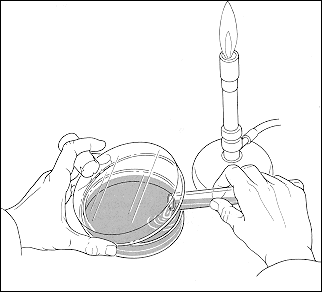



Cover the flask with a beaker or a piece of aluminum foil, and cover the culture tubes with caps, cotton plugs, or gauge plugs. Autoclave the media for 20 minutes. The heat of sterilization will dissolve the agar. Place a watch glass over the flask.
Set the media on a bench top and cool until the flask can be handled with your bare hands. Wrap paper towel around the neck of the flask when pouring agar into Petri dishes just in case the media reheats the glassware as the hot liquid passes through the neck in the process of pouring. Of course, one cannot pour out a block of solidified agar if the flask is cooled excessively. The agar will solidify at approximately 42ºC; thus, the temperature window for handling the liquefied agar is quite narrow. If the agar starts to solidify at the bottom as a result of not pouring fast enough, the flask can be gently heated with a flame to raise the temperature and melt the agar.
Stack sterile Petri dishes in a row, three or four per stack, on a disinfected lab bench. The number os dishes per stack can be adjusted according to the size of the student's hand. With the right hand holding the neck of the flask, open the cover of the lowest Petri dish with the left hand just wide enough to pour the media. (The top cover is the larger dish of the two; the actual dish is the smaller one.) Pour about 12 ml into each Petri dish. If too little agar is poured, there may not be enough to cover the dish or the agar plate will dry up easily. If too much is poured, the cover dish will come in contact with the nutrient agar, leaving no room for microbial growth. The plates are rendered useless either way. After pouring the bottom dish, pour the second one from the bottom, and so on until the entire stack is poured. Proceed to the next stack until all dishes are poured.
Immediately clean the flask with hot water before the residual agar solidifies, or have fun painstakingly scraping out the solidified agar from the flask.
Leave the plates undisturbed until the agar solidifies. The plates may now be streaked.

Method I
Petri dish preparation:
Mix the following nutrient ingredients in proportion to the amount required. Note that a Petri dish pour requires about 12 ml and a slant needs 6 ml. Adjust the pH to the desired value (pH=5.0) with 0.1N HCl or 0.1N KOH. If a large number (more than 5) of plates are to be poured, mix the nutrient in 1-2 liter flasks. It is difficult to handle flasks larger than 2 liters with one hand. If only a few (less than 5) are needed, the nutrient can be divided and poured into test tubes, each holding enough media for one Petri dish. The advantage of using test tubes is that they can be autoclaved separately and may later be heated to melt the agar in a beaker of boiling water. The liquefied agar may then be poured into a Petri dish directly from the test tube. However, the use of test tubes is not practical when making large quantities of agar plates.
YPG (yeast extract- Peptone- Glucose) Agar
Yeast extract
Peptone
Glucose
Agar
5g
10g
5g
15g
Add water to make 1 liter
*5 g/l of glucose may be substituted for lactose and sucrose.
EMB (Eosin- Methylene Blue) Agar
Peptone
Lactose *
Sucrose *
Dipotassium phosphate
Agar
Eosin
Methylene blue
10g
5g
5g
2g
13.5g
0.4g
0.065g
Add water to make 1 liter

 |
Yeast Culturing Page |  |